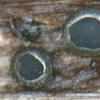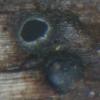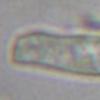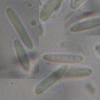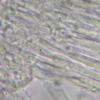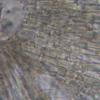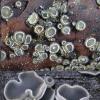
07-12-2025 16:07
Arnold BüschlenHallo, ich habe in einer Moos-Aufsammlung (epiphy

08-12-2025 21:04
Mark Stevens"Hello everyone,I'm relatively new to microscopy (

09-12-2025 12:06
 Andgelo Mombert
Andgelo Mombert
Bonjour,Je recherche l'article concernant Hypobryo

08-12-2025 18:59
 Lothar Krieglsteiner
Lothar Krieglsteiner
.. found by a seminar-participant, I do not know t

08-12-2025 17:37
 Lothar Krieglsteiner
Lothar Krieglsteiner
20.6.25, on branch of Abies infected and thickened

16-03-2014 22:00
Hello,I found this species a few months ago but ha

08-12-2025 13:39
Thomas Læssøehttps://svampe.databasen.org/observations/10572899
Dermateaceae s/ Cirsium palustre
Luc Bailly,
29-05-2010 21:35
Apothécie sessile, -> 1-1.5 mm de diamètre, brun noirâtre extérieurement avec une marge poilue plus claire; hyménium gris foncé, tirant sur le bleuté, parfois le brunâtre.
Excip. ectal text. glob. à cellules brun foncé. Poils de la marge brunâtres, septés, 58-63 x4-5 µ.
Asques 8-sp, à crochets; spores bisériées. IKI bleu.
Spores hyalines, non septées, avec parfois quelques petites guttules, 6.5-10 x 1.5-2 µ.
Paraphyses réfringentes, cylindriques ou faiblement clavées au sommet, x 2.5-4 µ, ne réagissant pas dans le KOH.
J'avais émis l'hypothèse de Pyrenopeziza revincta. Votre avis?
Amitiés - LUC.
Luc Bailly,
29-05-2010 21:36
Hans-Otto Baral,
29-05-2010 22:17

Re:Dermateaceae s/ Cirsium palustre
As far as I can see the paraphyses and hairs do not contain refringent vacuoles. Also the macro reminds me of a Pyrenopeziza rather than a Mollisia. P. revincta is a Mollisia, with VBs that react yellow in KOH.
Pyrenopeziza spec.
Zotto
Pyrenopeziza spec.
Zotto
Luc Bailly,
29-05-2010 23:12
Re:Dermateaceae s/ Cirsium palustre
Hm. I will check the refs I have about the Pyrenopeziza. By the way, I found something very similar from the sphagnum bog of Arcon in what I took back home from France. And also on Cirsium palustre.
Andreas Gminder,
08-06-2010 14:13

Re:Dermateaceae s/ Cirsium palustre
Hello,
in my opinion this is the very common Pyrenopeziza escharodes s.l. (possibly still a collective species). Mollisia revincta never has such elongate cells, but in the opposite distinctly round cells, even the marginal cells are nearly round. NANNFELDT did describe some of the taxa around Mollisia atrata (which is Pyrenopeziza escharodes in my opinion), so may be you find something there.
best regards,
Andreas
in my opinion this is the very common Pyrenopeziza escharodes s.l. (possibly still a collective species). Mollisia revincta never has such elongate cells, but in the opposite distinctly round cells, even the marginal cells are nearly round. NANNFELDT did describe some of the taxa around Mollisia atrata (which is Pyrenopeziza escharodes in my opinion), so may be you find something there.
best regards,
Andreas
Hans-Otto Baral,
08-06-2010 16:36

Re:Dermateaceae s/ Cirsium palustre
Hi Andreas
I am surprized about your opinion on P. escharodes. I thought this is a species typically on Rubus, with a strongly white-fringed margin, and erumpent, see also Breitenbach pl. 281.
P. atrata is smooth at the margin and superficial. I attach both, the upper from Chemnitz on Rubus idaeus, the lower from Mecklenburger Seenplatte, on Epilobium hirsutum.
Of course, the question of the identity of the types may be obscure.
Zotto
I am surprized about your opinion on P. escharodes. I thought this is a species typically on Rubus, with a strongly white-fringed margin, and erumpent, see also Breitenbach pl. 281.
P. atrata is smooth at the margin and superficial. I attach both, the upper from Chemnitz on Rubus idaeus, the lower from Mecklenburger Seenplatte, on Epilobium hirsutum.
Of course, the question of the identity of the types may be obscure.
Zotto
Luc Bailly,
08-06-2010 21:10
Re:Dermateaceae s/ Cirsium palustre
Hello Andreas, hello Zotto,
Thanks for your explanations. Do you have the complete ref for Nannfeldt's paper, so I could check if it's available on Cyberliber?
And indeed, Zotto, the upper photo is much closer to what I found. Although I didn't notice my sample on Cirsium might be erumpant.
Cheers - LUC.
Thanks for your explanations. Do you have the complete ref for Nannfeldt's paper, so I could check if it's available on Cyberliber?
And indeed, Zotto, the upper photo is much closer to what I found. Although I didn't notice my sample on Cirsium might be erumpant.
Cheers - LUC.

